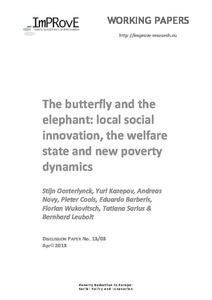The butterfly and the elephant: local social innovation, the welfare state and new poverty dynamics
"This paper surveys the literature on localized socially innovative policies and actions aimed at overcoming poverty and social exclusion. The authors show how these local forms of social innovation emerged in the late 1970s against the backdrop of the crisis and transformation of the Western w...
| Main Authors: | , , , , , , , , |
|---|---|
| Institution: | ETUI-European Trade Union Institute |
| Format: | TEXT |
| Language: | English |
| Published: |
Antwerp
2013
ImPRovE |
| Subjects: | |
| Online Access: | https://www.labourline.org/KENTIKA-19124109124919423819-The-butterfly-and-the-elephant.htm |
| Summary: | "This paper surveys the literature on localized socially innovative policies and actions aimed at overcoming poverty and social exclusion. The authors show how these local forms of social innovation emerged in the late 1970s against the backdrop of the crisis and transformation of the Western welfare state, the emergence of new social risks and the transition from the Fordist to the knowledge based economy. The paper aims to learn about new or older but as yet too often overlooked poverty and social exclusion dynamics from the locally embedded and collective responses to it by civil society associations, local state institutions and/or social entrepreneurs. The paper first develops a definition of social innovation as it applies to the fight against poverty and social exclusion. In a second part the authors put social innovation in its historical context by discussing three different strands of social innovation research and practice, namely: (1) social innovation as a critique of the territorial innovation model underlying the knowledge-based economy; (2) social innovation as a critique on the bureaucratic nature of the welfare state; and (3) socially innovative forms of neighbourhood development as a response to the urban crisis. The third section of the paper then zooms in on the process dimensions of social innovation for each of the three strands discussed in the second part. The authors propose the metaphor of ‘the elephant and the butterfly’ to think through the relationship between localized forms of socially innovative actions and initiatives on the one hand and the macro-level institutions of the welfare state and dialectical interplay between state institutions and civil society associations on the other. The paper concludes with a preliminary list of social needs, trends in poverty and the reconfiguration of welfare institutions and policies that are revealed by place-based socially innovative practices." |
|---|---|
| Physical Description: | 45 p. Digital |

